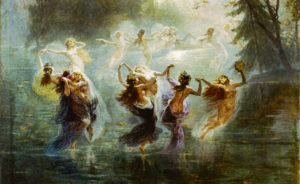On a tile high in the roof of a temple in Pietrabbondante in Italy, there are two messages. One is in Latin and the other in the ancient language of Oscan, but in English they read:
Detfri slave of Herennius Sattius
Signed with a footprint
Amica slave of Herennius
Signed when
We were placing the tile
The women’s footprints, and these inscriptions, are the only trace that they ever existed.
Amy Richlin includes this trace in her book, Arguments with Silence: Writing the History of Roman Women, because for most Roman women all we have is silence. And not just Roman women. Janina Ramirez’s new book Femina sets out to tell the history of the Middle Ages, “through”, as the subtitle puts it, “the women written out of it” — or never written in. The vast majority of people who have ever lived were illiterate and disenfranchised: they left no autographical sign of their existence and were simply not powerful or privileged enough to have their perspective represented in the documentary sources that survive. This is especially true of women.
The survivors who present themselves to a feminist historian are the exceptions. Ramirez tells the story of the thrilling post-Second World War mission to preserve the Reisencodex: the priceless manuscript that contains nearly all the collected writings of the extraordinary theologian, composer, and scientist Hildegard of Bingen; we have her surviving correspondence with three popes, King Henry II of England and Queen Eleanor of Aquitaine. And there’s Margery Kempe, whose book — only rediscovered in 1934 — tells her life as she narrated it to three scribes. (“Although not written down in her own hand,” says Ramirez, “this is the closest we can get to hearing a medieval woman speak to us from six centuries ago”.)
Those scribes were men, meaning even feminist histories must depend on male authorship. Almost everything we know about Eadburh, eighth-century queen of the West Saxons, comes from Bishop Asser’s biography of Alfred the Great, in which he casts her as the archetypal evil woman: tyrannical, murderous, both a cock-tease and a whore. Even Hildegard was edited by a man, Gebeno of Eberbach, whose decontextualised versions of her words were circulated far more widely than her own manuscripts.
For most women, though, what we know about them amounts to — at most — fragments. This creates problems for feminist historians. “Very few [historians] begin discussions of the Bayeux Tapestry thinking about the women who made it,” Ramirez observes, because we don’t know who they were or where they were.
To find women, Ramirez suggests, we must move beyond texts. For the early Middle Ages especially, restoring women to history involves triangulating findings from archaeology, osteoarchaeology, material culture and DNA. This means the close examination of surviving stuff — the bed burials of early medieval noblewomen, the so-called Loftus Princess’s gold and cloisonné jewels, or Jadwiga of Poland’s fourteenth-century ivory casket. In the case of the Loftus Princess, buried in a seventh-century grave where bone, wood, and fabric have disintegrated, her jewels — including one large pendant set in gold, with a scallop-shaped garnet surrounded by rows of gemstones — indicate both her status and, probably, her gender.
Ramirez also tells the story of the two people buried in style on a ninth-century ship in Tønsburg, Norway with every conceivable item “from enameled buckets to dog collars”: what a joy to discover, through bone analysis, that these fêted individuals were an elderly and a middle-aged woman respectively. Why two women were buried with such honour remains a mystery. It turns ideas about the masculine machismo of Viking society on their head.
DNA analysis in 2017 also caused surprise by revealing the tenth-century Birka warrior — who was buried with an axe, two shields, a spear, and a sword — to be a woman. She was not the only female warrior: the most famous queen of the Saxons, Ætheflæd, Lady of Mercia, was a military leader. And, according to isotope analysis, by Dr Cat Jarman, of the remaining bones of 264 individuals from the so-called Great Heathen (Viking) army, some 20% of the Viking army were women too.
Numismatics can also help the feminist historian: the eighth-century Queen of the Mercians, Cynethryth, wife of Offa, is depicted on coins, as is Irene, Emperor of Constantinople. Jadwiga was a female King of Poland, just as, three centuries later, Christina became a 17th-century King of Sweden; if you want to borrow men’s status, you sometimes have to borrow male terms.
Nevertheless, women who have enough burial stuff to be identified in death, were, like the women on coins, nearly always women of status. When it comes to writing the histories of these elite, well-known women, there is the further danger of hagiography — either because they have literally been canonised, like Hildegard and Jadwiga, or because, as in Jadwiga’s case, they have become secular saints hijacked for nationalist purposes. Ramirez is alive to the dangers of writing about exceptional individuals but doesn’t always go far enough to avoid them. One of her solutions is to offer brief parallels, for example, to show “that there was more than one twelfth-century woman challenging the status quo”.
And here another pitfall lies. The discovery by the University of Stockholm that the Birka warrior was a woman was immediately subject to scholarly scepticism and popular disbelief. This reaction says much about how we project onto the past — but all of us who search for people other than rich white men in history must refrain from an equally strong temptation to project: the temptation to romanticise. As Stephanie Smallwood puts it, we have to recognise our desire “for the subaltern [to be a] heroic actor whose agency triumphs over the forces of oppression”. Of course, we want women in the past to have defied the patriarchy and come up top — but most didn’t.
Romanticisation shades into a desire to portray exceptional women as in some ways representative. Ramirez suggests that Kempe gives us a glimpse of “an ordinary married woman, mother to fourteen children”, but the weeping, wailing visionary is not very ordinary, and, as Ramirez points out, Kempe’s book says next to nothing about those children. This absence of insight into the historical experience of mothering is not unusual but — given that motherhood was a near-universal experience before the advent of reliable contraception — it is startling. The cradle-side experience was, in the view of Sarah Knott, either considered too mundane to be written down or went unrecorded because women whose hands were too full of children had neither the time nor the ability to pick up a quill.
Ramirez is strongest when on her home ground of the early Middle Ages. For the late medieval period, the pursuit of ordinary women requires the reading of manuscript evidence against the grain. Court records have produced rich results: analysis of the trial of Alice Kyteler in 1324, the first condemned witch in Ireland, or Emmanuel Le Roy Ladurie’s account of the Inquisition’s interrogations of male and female Cathars in southern France in his Montaillou (1975). He examined the worldview of Pyrenean villagers between 1294 and 1324 through the testimonies that they gave to Bishop Jacques Fournier, producing chapters called “Body language and sex”, “Marriage and the condition of women”, “Concepts of time and space”, and “Fate, magic, and salvation”. Some of Ladurie’s handling of his material does not show the care and critical analysis with which later historians have treated depositions, but his findings still provide compelling insights into the lives of ordinary women and men.
There are women in the criminal records from the Court of the King’s Bench; they are also to be found in wills, petitions, household accounts, and medical texts — annotated, or sometimes even composed by, women. Monica Green edited and translated the Trotula, an amazing collection of medieval medical and cosmetic advice for women. Louise Wilkinson (whose Twitter handle is, incidentally, @MedievalFemina) drew on charters, chronicles, government records and early manorial court rolls to examine the experiences of noble- and gentlewomen, urban women, peasant women, and criminal women in thirteenth-century Lincolnshire. Rachel Delman used tapestries to examine ritual in the fifteenth-century household headed by Alice Chaucer, while Jessica Barker has written about the tomb effigies of the Middle Ages to explore gender, marriage, and emotion. And that’s just to scratch the surface.
So the medieval women that Ramirez has reappraised are not exactly common or garden. She has, still, re-examined a handful of influential women in the easy-to-read, enthusiastic prose that is her hallmark. Femina is demotic in style: things “languish” in archives, villages are always “sleepy”, and Ramirez uses the present tense for drama, whether in 1077 or 1983. Troubadours are the “medieval equivalent of touring rock stars”, creatures in the margins of psalters are “lookalikes of… Yoda and Gandalf”. Perhaps most surprisingly, “medieval pilgrimage was like our modern-day package holidays”.
This is deliberate, for this is as much a book about our interactions with the past as it is about the past itself. It is in the nature of feminist history to have an agenda. Richlin acknowledged that, “in telling women’s stories, I am working toward a society that remembers women”. Saidiya Hartman explains that “every generation confronts the task of choosing its past… The past depends less on ‘what happened then’ than on the desires and discontents of the present”. Ramirez is upfront about the way her work is representative of our current age; still, it raises broader questions about the perils of letting the present weigh too heavily on the past.
Is it helpful for modern doctors and psychiatrists to analyse Hildegard’s visions, nine centuries on, to see “whether they indicate underlying medical or mental health issues”? Ramirez concludes that “it was highly probable she was experiencing migraines”; later, this is a certainty: “her whole body was affected by the migraines”. Elsewhere, she explains Hildegard’s visions away by reference to the menopause. Margery Kempe, we’re told, might be diagnosed today as schizophrenic, epileptic or psychotic. Ramirez notes that some of Kempe’s contemporaries suggested epilepsy too — but these were her detractors, mocking her.
Being driven by the inequalities and injustices of our day to search for our ancestors in history is noble, but it isn’t easy. Men have been the powerful and the privileged for so long; to unbury the dead, feminist historians need to do some heavy lifting. But have we become so blinkered by the present that we cannot approach the past on its own terms? If the ideas in Hildegard’s visions were taken seriously by the powerful men who were her contemporaries but not by feminist historians — then who is writing whom out of history?
Disclaimer
Some of the posts we share are controversial and we do not necessarily agree with them in the whole extend. Sometimes we agree with the content or part of it but we do not agree with the narration or language. Nevertheless we find them somehow interesting, valuable and/or informative or we share them, because we strongly believe in freedom of speech, free press and journalism. We strongly encourage you to have a critical approach to all the content, do your own research and analysis to build your own opinion.
We would be glad to have your feedback.
Source: UnHerd Read the original article here: https://unherd.com/






